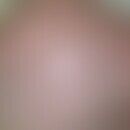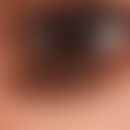Synonym(s)
DefinitionThis section has been translated automatically.
Rare, epidermal nevus of the hair follicles, characterized by grouped, mostly linearly arranged "comedone-like", symptomless follicular horny cysts.
Occurrence/EpidemiologyThis section has been translated automatically.
You might also be interested in
EtiopathogenesisThis section has been translated automatically.
Unknown; familial clustering of comedones nevi has been described in some families(Naevus comedonicus syndrome). In some cases defects of a thyrosine kinase receptor have been detected.
ManifestationThis section has been translated automatically.
Mostly during childhood (1-10 years), but also from birth or late manifested in adulthood.
LocalizationThis section has been translated automatically.
Face, also capillitium, on the trunk often segmental, on the extremities linear, also occurring on hairless body regions.
ClinicThis section has been translated automatically.
Organoid epidermal nevus manifested in linear, band-shaped or completely bizarre arrangement (Blaschko line pattern).
Usually unilateral, bizarrely limited, skin-coloured or even hyperpigmented lesion consisting of grouped, sharply defined, flat, often splatter-like, skin-coloured depressions, skin-coloured papules and nodules (epidermal cysts) and injected 0.2-0.3 cm dilated follicular openings (comedone-like) containing a black horn plug. In pronounced cases, a sieve-like pattern can be created by a glim-like formation of comedones.
This results in a knitting pattern like overall picture (see illustration).
HistologyThis section has been translated automatically.
Differential diagnosisThis section has been translated automatically.
TherapyThis section has been translated automatically.
Note(s)This section has been translated automatically.
In a few cases, comedonal nevus is a partial symptom of an epidermal nevus syndrome (see nevus , epidermal) with ispilateral cataract and bone defects as well as neurological defects (comedonal nevus syndrome as a neuro-cutaneous disease).
A variant of comedonal nevus is "epidermolytic comedonal nevus" with acantholytic areas in the surface epithelium.
LiteratureThis section has been translated automatically.
- Adya KA et al (2020) Epidermolytic nevus: An instance of mosaic epidermolytic hyosis. Indian Dermatol Online J 11:272-273.
- Alpsoy E et al (2005) Nevus comedonicus syndrome: a case associated with multiple basal cell carcinomas and a rudimentary toe. Int J Dermatol 44: 499-501
- Bongiorno MR et al (2003) Nevus comedonicus immunohistochemical features in two cases. Acta Derm Venereol 83: 300-301
- Ferrari B et al (2015) Nevus comedonicus: a case series. Pediatr Dermatol 32:216-219
- Ito T et al (2013) Bilateral nevus comedonicus syndrome. Yonago Acta Med 56:59-61
- Kaliyadan F et al (2014) Nevus comedonicus of the scalp. Skinmed 12:59-60
- Kargi E et al (2003) Nevus comedonicus. Plast Reconstr Surg 112: 1183-1185.
- Kofmann S (1885) A case of rare localization and distribution of comedones. Arch Dermatol Syphil (Berlin) 32: 177-178.
- Lefkowitz A et al (1999) Nevus comedonicus. Dermatology 199: 204-207
- Nilles M et al (1992) Nevus follicularis keratosus: clinic, histology and histogenesis. Dermatologist 43: 205-209
- Tchernev G et al (2013) Nevuscomedonicus: an updated review. Dermatol Ther (Heidelb) 3:33-40.
- Yadav P et al (2015) Nevus comedonicus syndrome. Indian JDermatol 60: 421
Incoming links (9)
Atrophoderma vermiculatum; Comedo-follicular nevus; Comedon nevus; Corneal clouding; Epidermal nevus organoid; Keratotic nevus; Komedo; Naevus comedonicus syndrome; Trichilemmocystic nevus;Disclaimer
Please ask your physician for a reliable diagnosis. This website is only meant as a reference.








